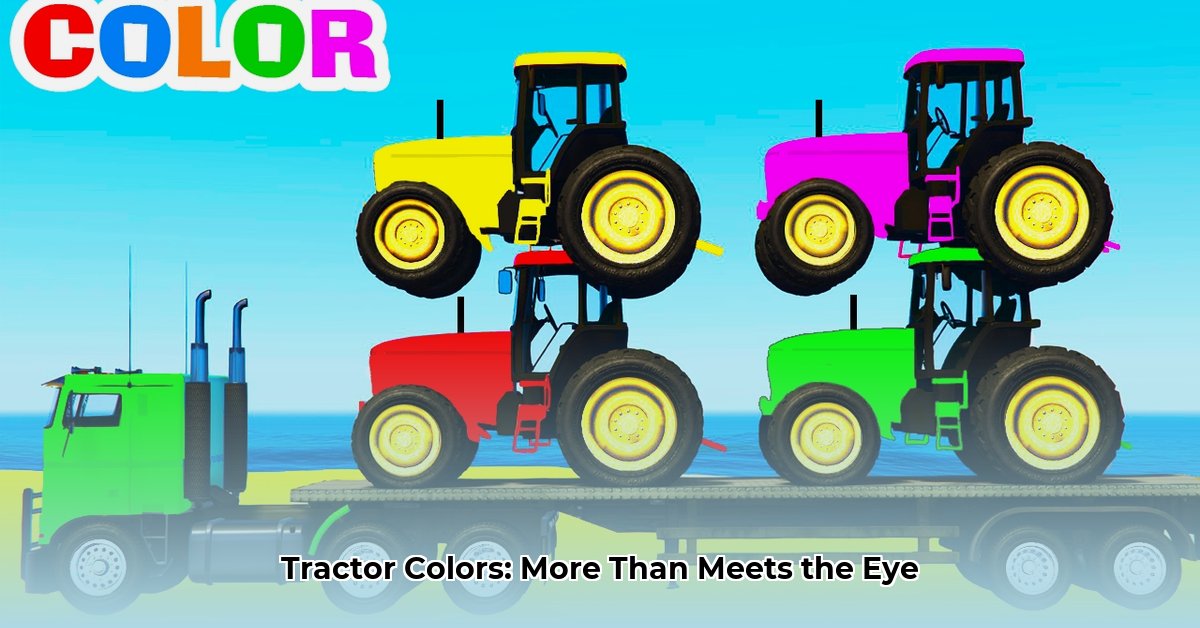
A Colorful History: From Drab to Daring
The vibrant hues adorning modern tractors—the iconic greens, bold reds, and cheerful oranges—tell a compelling story. It's a narrative woven from branding strategies, crucial safety advancements, and even burgeoning environmental concerns. Early tractors, born from the Industrial Revolution, were typically utilitarian shades of black and gray, reflecting a focus on function over form. However, manufacturers soon recognized the power of color in building brand recognition and customer loyalty. John Deere's legendary green, for example, became synonymous with quality and dependability, while International Harvester's striking red rapidly established its own strong market presence. This wasn't mere aesthetics; it was strategic branding. For more on tractor paint colors, see this helpful resource.
But the story significantly shifted after the 1930s. As farming became more complex, safety took center stage. Brighter colors, especially red and orange, gained prominence. Why the change? Increased visibility. Brighter tractors stand out in diverse field conditions, significantly reducing accident risks for both workers and machinery. This wasn't a cosmetic update; it was a pivotal safety improvement. Imagine the difference: a dark tractor blending into a dusky field versus a vibrant red one. The improvement in visibility is undeniable, profoundly impacting farmworker safety. These bright colors serve as a silent, painted-on safety message.
This enhanced safety translates directly into sustainable farming practices. Fewer accidents mean less equipment downtime, lower repair costs, and a healthier workforce—the very foundation of a successful farming operation. Furthermore, tractor manufacturers are increasingly adopting eco-friendly paint technologies, minimizing their environmental impact. This commitment to both worker safety and environmental responsibility highlights a holistic approach to sustainable agriculture.
The evolution of tractor colors continues. As farming practices change and safety technologies advance, manufacturers will adapt their color choices accordingly. The future might hold even more vibrant hues, perhaps colors specifically chosen for optimal visibility under varying environmental factors. The possibilities are vast. But one thing remains constant: the narrative of tractor colors is an ongoing story of innovation, safety, and sustainable agricultural practices.
Actionable Intelligence: A Multi-Stakeholder Approach
Here's how different stakeholders can contribute to safer, more sustainable farming:
For Farmers and Agribusinesses:
- Prioritize Visibility Assessments: Regularly evaluate your tractor's visibility in various conditions. Repainting older models with brighter colors can significantly improve safety.
- Conduct Cost-Benefit Analyses: Analyze the financial impact of repainting or purchasing higher-visibility tractors. Weigh the costs against potential reductions in accidents and downtime. The potential ROI can be substantial.
- Champion Research Initiatives: Support studies that quantitatively link tractor color to accident rates. Data-driven insights will inform better safety practices.
For Tractor Manufacturers:
- Gather Farmer Feedback: Conduct comprehensive surveys to understand farmer needs regarding color visibility and preferences. Use this data to inform design decisions.
- Develop Sustainable Paint Technologies: Invest in research to develop eco-friendly, high-performance paints minimizing environmental impact. This commitment strengthens your brand image and environmental responsibility.
- Integrate Advanced Safety Features: Design tractors with enhanced lighting, improved visibility technologies, and safety technology integrations. This proactive stance directly contributes to workforce safety and brand reputation.
For Regulatory Bodies:
- Modernize Safety Standards: Regularly update regulations concerning the visibility of agricultural machinery. Consider implementing stricter guidelines to enforce better equipment safety.
- Commission Comprehensive Studies: Fund research into how environmental factors influence tractor visibility in different regions. This data will inform evidence-based safety regulations.
How to Improve Tractor Visibility for Farm Safety and Sustainability
Tractor color isn't just aesthetics; it's a crucial safety feature. While bright colors significantly enhance visibility, a multi-faceted approach is essential:
- Maintain SMV (Slow-Moving Vehicle) Emblems: Ensure proper placement and maintenance of SMV emblems. These serve as clear warnings to other drivers.
- Upgrade Lighting Systems: Add supplemental lights, especially to the rear and sides, for increased visibility in low-light conditions. Reflective tape further enhances visibility.
- Utilize Reflective Materials: Strategically place reflective tape or decals to make the tractor more noticeable, particularly to oncoming traffic.
- Employ Warning Lights and Flashers: Flashing lights, especially in poor weather or busy traffic, grab attention and communicate the presence of slower-moving equipment.
- Invest in Driver Training: Increase operator and public awareness of the safety challenges posed by farm machinery on roads. Consistent training fosters safer habits.
- Advocate for Consistent Regulations: Promote uniform safety regulations across regions regarding SMV emblems, lighting standards, and speed limits.
Modern technology also plays a vital role. Advanced features like automatic emergency braking and GPS trackers enhance both tractor and road safety. Remember: bright colors are a key element, but a comprehensive approach to visibility dramatically improves farm safety and sustainability.